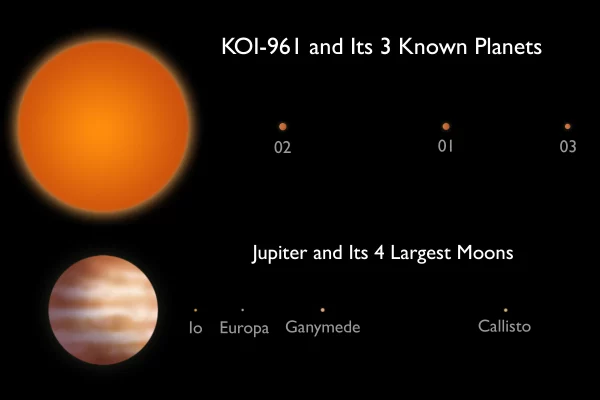The vast universe has always been a great source of inspiration for scientists, with marvelous discoveries that we still cannot fully explain. Recently, NASA made another significant breakthrough in the journey of space exploration when astronomers discovered the smallest star system with three exoplanets orbiting around it. This discovery not only broadens our understanding of planets beyond the Solar System but also serves as evidence of the immense diversity of the universe.
“These three exoplanets are smaller than Earth and are part of a small star system we call KOI-961,” scientists from NASA said. These planets have radii of 0.78, 0.73, and 0.57 of Earth’s radius, with the smallest planet being roughly the size of Mars. What makes these three exoplanets remarkable is that they are all likely to be formed from rocky material, similar to Earth, but they are located too close to their star to exist in a habitable zone that could support life.
Orbiting a red dwarf star named KOI-961, these discoveries open an exciting perspective on the formation of planetary systems in the universe. “The KOI-961 star system is the smallest ever discovered, and in terms of scale, it can be compared to our own Solar System, but with significant differences in composition and structure,” said John Johnson, the lead researcher at NASA’s Institute for Exoplanet Science. The KOI-961 star has a diameter only one-sixth that of the Sun but is still 70% larger than Jupiter, illustrating the intriguing differences between red dwarf stars and the larger stars we are used to seeing.
“This planet orbits very close to KOI-961 and completes one orbit in less than two days,” scientists noted. The planet closest to KOI-961 is KOI-961.03, and it is estimated that its temperature could reach hundreds of degrees Celsius, making the possibility of liquid water almost impossible.
This discovery was made by a team of researchers from the California Institute of Technology, led by John Johnson. They used publicly available data from NASA’s Kepler mission, combined with observations from ground-based observatories such as the Palomar Observatory and the Keck Observatory in Hawaii, to accurately determine the size of these planets. Previously, estimates of the sizes of these planets had been inaccurate, but with modern technology, the research team was able to make a more precise determination.
“The discovery of three such small planets is a sign that we may find even more smaller rocky planets in the future,” said Phil Muirhead, the lead author of the study. Recent studies have also suggested that there may be many Earth-like planets orbiting red dwarf stars in the Milky Way. These planets could exist in far-off and lesser-known regions, opening up opportunities for researchers to explore the wonders of the universe.
With these discoveries, NASA’s Kepler mission continues to solidify its crucial role in expanding our understanding of exoplanets. In particular, the discovery of such rocky planets not only provides insight into the diversity of star systems but also offers strong motivation for scientists in their search for planets that may support life.

This discovery continues to spark the curiosity of space and science enthusiasts, while also inspiring those who wish to participate in astronomical observation events or follow future space missions.


HPX24h > Space > The Smallest Star System with Three Exoplanets Found by NASA’s Kepler
Tagged Articles
Habitable Exoplanets: Exploring Distant Worlds
Top Reads from This Category
Space
The Milky Way’s Central Black Hole: The Asteroid Annihilator
Space
The Relationship Between Star Formation and the Activity of Supermassive Black Holes
Space
Over 100 Billion Planets in the Milky Way: Astonishing Discoveries About the Universe
Space
Exploring Gravitational Forces and the Evolution of the Universe
Space
Exploring Saturn’s Moon Phoebe: Planet-Like Features and Characteristics
Space
Scientists Believe Water Ice Could Exist on the Giant Asteroid Vesta
Space
18 New Planets: Unlocking the Gateway to Exploring Giant Star Systems
Discover New Topics
Science
Mind-Controlled Prosthetics: A Groundbreaking Advancement in Medicine
Animals
Rats Help Each Other: When Compassion Emerges from Small Creatures
Animals
The Stunning Image of a Cheetah in Action During Its Hunt
Animals
Gibbons Develop Vocal Techniques as Powerful as Humans: New Discoveries About Their Unique Sounds
Science
Enhancing Memory with Brain Implants: A New Scientific Revolution
Health
Chemicals in Tattoo Ink: Are They Linked to Blood and Skin Cancer?
Fitness
Muscles: The Golden Key to Effective Health and Performance
Science
Blood Test: A Breakthrough in Early Detection of Alzheimer’s Disease
Parenting Tips
Discover How Japan’s Education System Creates Self-Disciplined, Responsible Students Without the Need for Pressure
Parenting Tips
Talking to Children About Race: How to Make It Easier?
Fitness
Postpartum Fitness: Secrets to Maintaining an Active Routine for a Quick Recovery
Space
Habitable Exoplanets: Exploring Distant Worlds
Science
AI Can Make Life Easier, But Is It Harming Your Ability to Think Critically?